Sijie Cheng
StableToolBench-MirrorAPI: Modeling Tool Environments as Mirrors of 7,000+ Real-World APIs
Mar 26, 2025



Abstract:The rapid advancement of large language models (LLMs) has spurred significant interest in tool learning, where LLMs are augmented with external tools to tackle complex tasks. However, existing tool environments face challenges in balancing stability, scalability, and realness, particularly for benchmarking purposes. To address this problem, we propose MirrorAPI, a novel framework that trains specialized LLMs to accurately simulate real API responses, effectively acting as "mirrors" to tool environments. Using a comprehensive dataset of request-response pairs from 7,000+ APIs, we employ supervised fine-tuning and chain-of-thought reasoning to enhance simulation fidelity. MirrorAPI achieves superior accuracy and stability compared to state-of-the-art methods, as demonstrated by its performance on the newly constructed MirrorAPI-Bench and its integration into StableToolBench.
VidEgoThink: Assessing Egocentric Video Understanding Capabilities for Embodied AI
Oct 15, 2024Abstract:Recent advancements in Multi-modal Large Language Models (MLLMs) have opened new avenues for applications in Embodied AI. Building on previous work, EgoThink, we introduce VidEgoThink, a comprehensive benchmark for evaluating egocentric video understanding capabilities. To bridge the gap between MLLMs and low-level control in Embodied AI, we design four key interrelated tasks: video question-answering, hierarchy planning, visual grounding and reward modeling. To minimize manual annotation costs, we develop an automatic data generation pipeline based on the Ego4D dataset, leveraging the prior knowledge and multimodal capabilities of GPT-4o. Three human annotators then filter the generated data to ensure diversity and quality, resulting in the VidEgoThink benchmark. We conduct extensive experiments with three types of models: API-based MLLMs, open-source image-based MLLMs, and open-source video-based MLLMs. Experimental results indicate that all MLLMs, including GPT-4o, perform poorly across all tasks related to egocentric video understanding. These findings suggest that foundation models still require significant advancements to be effectively applied to first-person scenarios in Embodied AI. In conclusion, VidEgoThink reflects a research trend towards employing MLLMs for egocentric vision, akin to human capabilities, enabling active observation and interaction in the complex real-world environments.
Instruction-Guided Visual Masking
May 30, 2024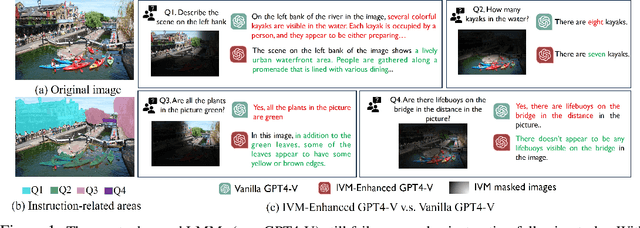
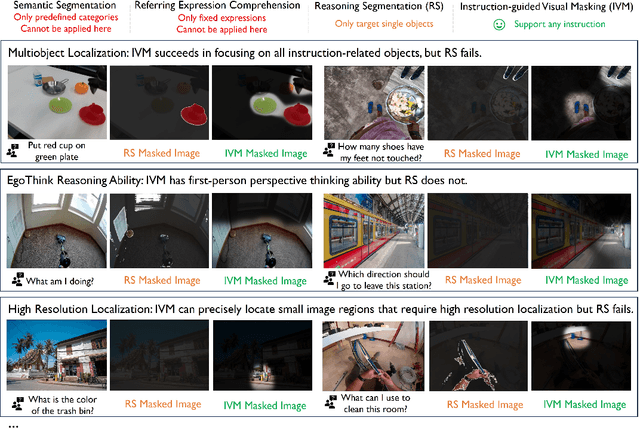

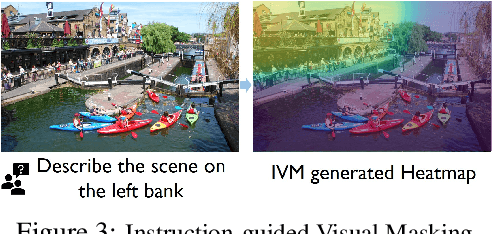
Abstract:Instruction following is crucial in contemporary LLM. However, when extended to multimodal setting, it often suffers from misalignment between specific textual instruction and targeted local region of an image. To achieve more accurate and nuanced multimodal instruction following, we introduce Instruction-guided Visual Masking (IVM), a new versatile visual grounding model that is compatible with diverse multimodal models, such as LMM and robot model. By constructing visual masks for instruction-irrelevant regions, IVM-enhanced multimodal models can effectively focus on task-relevant image regions to better align with complex instructions. Specifically, we design a visual masking data generation pipeline and create an IVM-Mix-1M dataset with 1 million image-instruction pairs. We further introduce a new learning technique, Discriminator Weighted Supervised Learning (DWSL) for preferential IVM training that prioritizes high-quality data samples. Experimental results on generic multimodal tasks such as VQA and embodied robotic control demonstrate the versatility of IVM, which as a plug-and-play tool, significantly boosts the performance of diverse multimodal models, yielding new state-of-the-art results across challenging multimodal benchmarks. Code is available at https://github.com/2toinf/IVM.
ConvLLaVA: Hierarchical Backbones as Visual Encoder for Large Multimodal Models
May 24, 2024Abstract:High-resolution Large Multimodal Models (LMMs) encounter the challenges of excessive visual tokens and quadratic visual complexity. Current high-resolution LMMs address the quadratic complexity while still generating excessive visual tokens. However, the redundancy in visual tokens is the key problem as it leads to more substantial compute. To mitigate this issue, we propose ConvLLaVA, which employs ConvNeXt, a hierarchical backbone, as the visual encoder of LMM to replace Vision Transformer (ViT). ConvLLaVA compresses high-resolution images into information-rich visual features, effectively preventing the generation of excessive visual tokens. To enhance the capabilities of ConvLLaVA, we propose two critical optimizations. Since the low-resolution pretrained ConvNeXt underperforms when directly applied on high resolution, we update it to bridge the gap. Moreover, since ConvNeXt's original compression ratio is inadequate for much higher resolution inputs, we train a successive stage to further compress the visual tokens, thereby reducing redundancy. These optimizations enable ConvLLaVA to support inputs of 1536x1536 resolution generating only 576 visual tokens, capable of handling images of arbitrary aspect ratios. Experimental results demonstrate that our method achieves competitive performance with state-of-the-art models on mainstream benchmarks. The ConvLLaVA model series are publicly available at https://github.com/alibaba/conv-llava.
StableToolBench: Towards Stable Large-Scale Benchmarking on Tool Learning of Large Language Models
Mar 13, 2024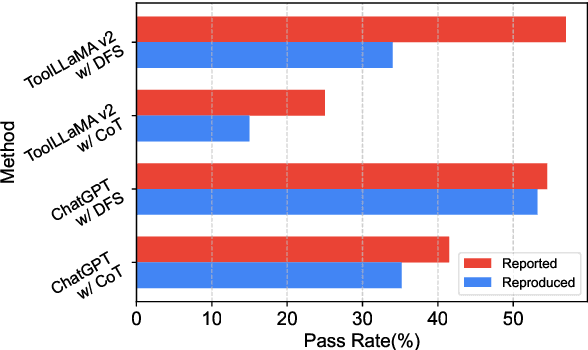
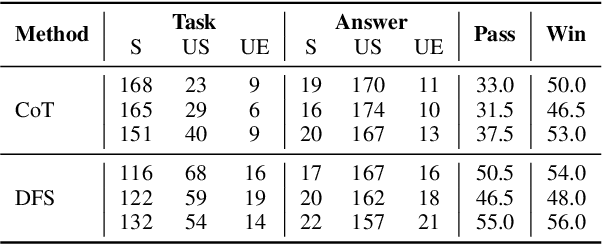
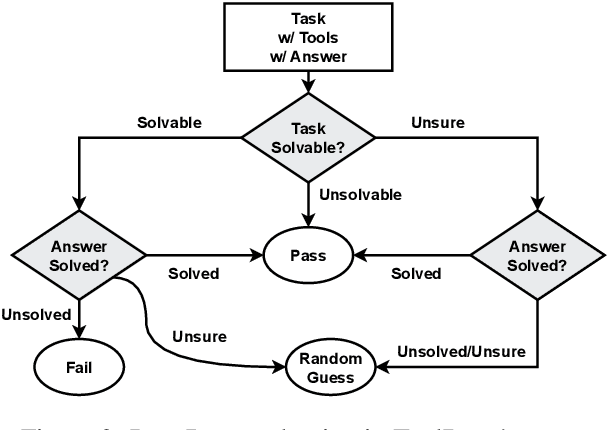

Abstract:Large Language Models (LLMs) have witnessed remarkable advancements in recent years, prompting the exploration of tool learning, which integrates LLMs with external tools to address diverse real-world challenges. Assessing the capability of LLMs to utilise tools necessitates large-scale and stable benchmarks. However, previous works relied on either hand-crafted online tools with limited scale, or large-scale real online APIs suffering from instability of API status. To address this problem, we introduce StableToolBench, a benchmark evolving from ToolBench, proposing a virtual API server and stable evaluation system. The virtual API server contains a caching system and API simulators which are complementary to alleviate the change in API status. Meanwhile, the stable evaluation system designs solvable pass and win rates using GPT-4 as the automatic evaluator to eliminate the randomness during evaluation. Experimental results demonstrate the stability of StableToolBench, and further discuss the effectiveness of API simulators, the caching system, and the evaluator system.
DecisionNCE: Embodied Multimodal Representations via Implicit Preference Learning
Feb 28, 2024Abstract:Multimodal pretraining has emerged as an effective strategy for the trinity of goals of representation learning in autonomous robots: 1) extracting both local and global task progression information; 2) enforcing temporal consistency of visual representation; 3) capturing trajectory-level language grounding. Most existing methods approach these via separate objectives, which often reach sub-optimal solutions. In this paper, we propose a universal unified objective that can simultaneously extract meaningful task progression information from image sequences and seamlessly align them with language instructions. We discover that via implicit preferences, where a visual trajectory inherently aligns better with its corresponding language instruction than mismatched pairs, the popular Bradley-Terry model can transform into representation learning through proper reward reparameterizations. The resulted framework, DecisionNCE, mirrors an InfoNCE-style objective but is distinctively tailored for decision-making tasks, providing an embodied representation learning framework that elegantly extracts both local and global task progression features, with temporal consistency enforced through implicit time contrastive learning, while ensuring trajectory-level instruction grounding via multimodal joint encoding. Evaluation on both simulated and real robots demonstrates that DecisionNCE effectively facilitates diverse downstream policy learning tasks, offering a versatile solution for unified representation and reward learning. Project Page: https://2toinf.github.io/DecisionNCE/
DEEM: Dynamic Experienced Expert Modeling for Stance Detection
Feb 23, 2024Abstract:Recent work has made a preliminary attempt to use large language models (LLMs) to solve the stance detection task, showing promising results. However, considering that stance detection usually requires detailed background knowledge, the vanilla reasoning method may neglect the domain knowledge to make a professional and accurate analysis. Thus, there is still room for improvement of LLMs reasoning, especially in leveraging the generation capability of LLMs to simulate specific experts (i.e., multi-agents) to detect the stance. In this paper, different from existing multi-agent works that require detailed descriptions and use fixed experts, we propose a Dynamic Experienced Expert Modeling (DEEM) method which can leverage the generated experienced experts and let LLMs reason in a semi-parametric way, making the experts more generalizable and reliable. Experimental results demonstrate that DEEM consistently achieves the best results on three standard benchmarks, outperforms methods with self-consistency reasoning, and reduces the bias of LLMs.
Speak It Out: Solving Symbol-Related Problems with Symbol-to-Language Conversion for Language Models
Jan 22, 2024



Abstract:Symbols (or more broadly, non-natural language textual representations) such as numerical sequences, molecular formulas, and table delimiters widely exist, playing important roles in various tasks such as abstract reasoning, chemical property prediction, and table question answering. Despite the impressive natural language comprehension capabilities of large language models (LLMs), their reasoning abilities for symbols remain inadequate, which could attributed to the difference between symbol representations and general natural languages. We propose symbol-to-language (S2L), a tuning-free method that enables large language models to solve symbol-related problems with information expressed in natural language. Specifically, S2L first converts the symbols involved to language-based representations, which can be implemented by prompting LLMs or leveraging external tools, then these language-based representations are integrated into the original problem via direct substitution or concatenation, serving as useful input information for LLMs. We evaluate the S2L method using both API-based (GPT-4, ChatGPT) and open-source (OpenChat) models over eight symbol-related tasks, ranging from symbol-only abstract reasoning to sentiment analysis in social media. Experimental results show that S2L consistently leads to superior performance. For example, by employing S2L for GPT-4, there can be average significant improvements of +21.9% and +9.5% for subtasks in 1D-ARC and Dyck language, respectively. Codes and data are available at https://github.com/THUNLP-MT/symbol2language.
Can Vision-Language Models Think from a First-Person Perspective?
Nov 27, 2023



Abstract:Vision-language models (VLMs) have recently shown promising results in traditional downstream tasks. Evaluation studies have emerged to assess their abilities, with the majority focusing on the third-person perspective, and only a few addressing specific tasks from the first-person perspective. However, the capability of VLMs to "think" from a first-person perspective, a crucial attribute for advancing autonomous agents and robotics, remains largely unexplored. To bridge this research gap, we introduce EgoThink, a novel visual question-answering benchmark that encompasses six core capabilities with twelve detailed dimensions. The benchmark is constructed using selected clips from egocentric videos, with manually annotated question-answer pairs containing first-person information. To comprehensively assess VLMs, we evaluate eighteen popular VLMs on EgoThink. Moreover, given the open-ended format of the answers, we use GPT-4 as the automatic judge to compute single-answer grading. Experimental results indicate that although GPT-4V leads in numerous dimensions, all evaluated VLMs still possess considerable potential for improvement in first-person perspective tasks. Meanwhile, enlarging the number of trainable parameters has the most significant impact on model performance on EgoThink. In conclusion, EgoThink serves as a valuable addition to existing evaluation benchmarks for VLMs, providing an indispensable resource for future research in the realm of embodied artificial intelligence and robotics.
OpenChat: Advancing Open-source Language Models with Mixed-Quality Data
Sep 20, 2023



Abstract:Nowadays, open-source large language models like LLaMA have emerged. Recent developments have incorporated supervised fine-tuning (SFT) and reinforcement learning fine-tuning (RLFT) to align these models with human goals. However, SFT methods treat all training data with mixed quality equally, while RLFT methods require high-quality pairwise or ranking-based preference data. In this study, we present a novel framework, named OpenChat, to advance open-source language models with mixed-quality data. Specifically, we consider the general SFT training data, consisting of a small amount of expert data mixed with a large proportion of sub-optimal data, without any preference labels. We propose the C(onditioned)-RLFT, which regards different data sources as coarse-grained reward labels and learns a class-conditioned policy to leverage complementary data quality information. Interestingly, the optimal policy in C-RLFT can be easily solved through single-stage, RL-free supervised learning, which is lightweight and avoids costly human preference labeling. Through extensive experiments on three standard benchmarks, our openchat-13b fine-tuned with C-RLFT achieves the highest average performance among all 13b open-source language models. Moreover, we use AGIEval to validate the model generalization performance, in which only openchat-13b surpasses the base model. Finally, we conduct a series of analyses to shed light on the effectiveness and robustness of OpenChat. Our code, data, and models are publicly available at https://github.com/imoneoi/openchat.
 Add to Chrome
Add to Chrome Add to Firefox
Add to Firefox Add to Edge
Add to Edge